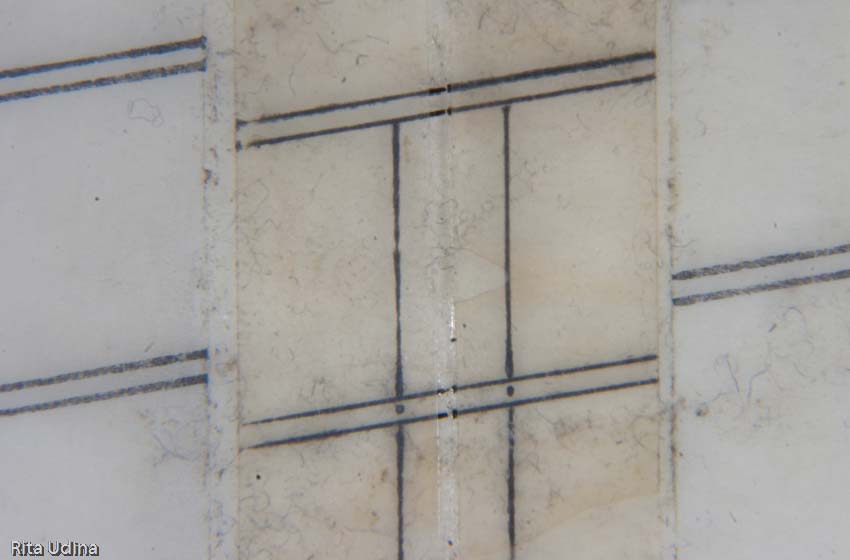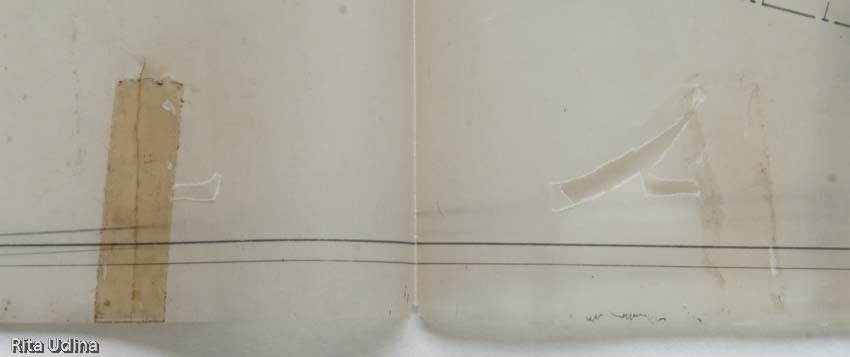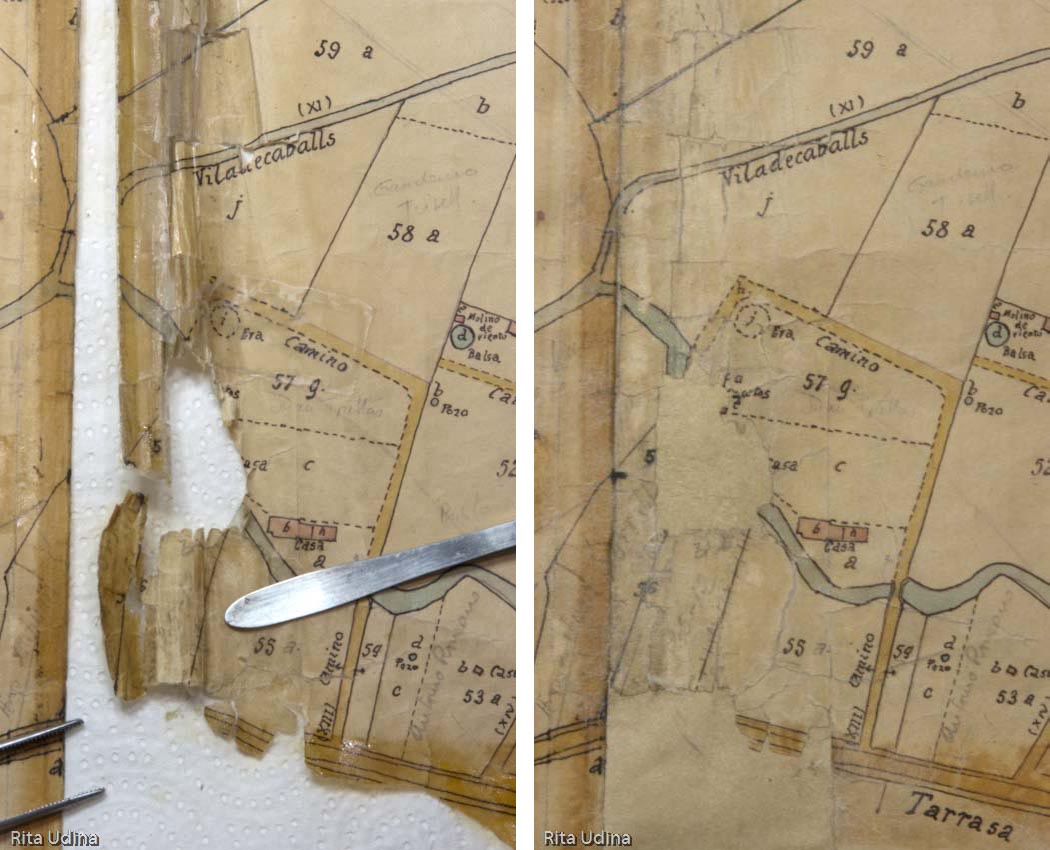Damned “sellotapes”!
Pressure sensitive tapes: Degradation mechanisms and removal
Sellotapes, Scotch tapes, these pressure-sensitive adhesives to “repair” paper, are part of numerous artefacts from documentary heritage in the need to be preserved. We owe Mr. Richard Drew this fabulous invention in 1925 (or 1930?).
The fatty adhesive accompanying the plastic strip oxidizes and stains the sticked paper, causing with time more damages than benefits. A solid knowledge of writing techniques and solvents will enable a quite satisfactory removal of this greasy glue.
Damages caused by tapes at medium and long term are:
1) Yellowing (and oxidation) of the paper affected.
Fat is not evaporated by a physical phenomenon (like water) but a chemical reaction (oxidation). The dark tone of paper is not only the effect of the fat still present, but also the oxidation of paper fibres. Chemical structure has changed, and so fibres are darker now.
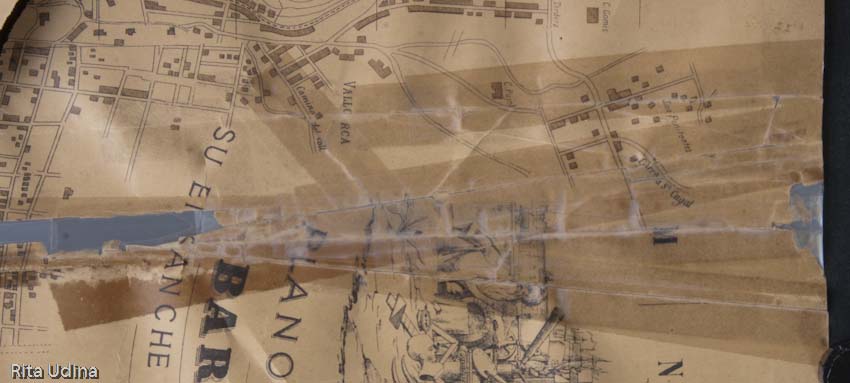
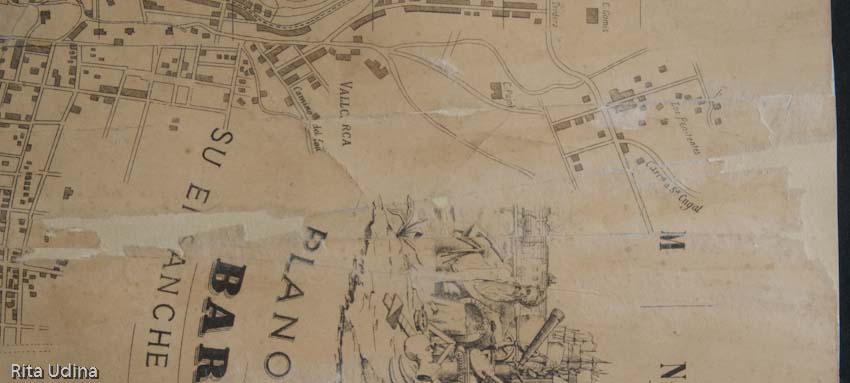
Detail of an oversized printed plan of Barcelona, 1900. Association of Architects of Catalonia (CoAC).
Could it be that tapes created a sort of sickly addiction that pushed to put it one and again on the same document?
2) Yellowing (and oxidation) of the neighbouring papers.
3) Weakening of the perimetral paper due to differential thickness, that form at the end tears next to the plastic strip, specially when paper is really thin -like this one, an onion skin paper-.
Detail of pencil architectural drawing on onion skin paper by the architect Barba Corsini (c.1960). Association of Architects of Catalonia (CoAC).
Discolouration and oxidation are evident both on the side where the tape is (left) and in the immediately adjacent area (right). The difference in strength between the paper and the plastic tape provokes tears, as the upper left tape shows. Furthermore sellotape has slipped significantly, unmatching the lines of the drawing.
4) Slipping of plastic supports and dirt adhesion. Moderately high temperatures can make the adhesive become labile, shifting the plastic strip from its original position. And as it is sticky, areas with no plastic are easily filled with dirt.
Macro detail of an architectural plan of Meridiana canodrom (Barcelona), by the architect Bonet Castellana (c. 1960). Ink manuscript on tracing paper, CoAC. In this tracing paper dirt was already there before putting the adhesive… No need for CSI special labs to see that! And yet it is so common that those ones who use these tapes are not the kind of very clean and meticulous ones. Look at the plastic strips, which has slipped when heat melted fat.
And you might be wondering… why isn’t she sowing the “after” images for these plans? Wasn’t she able to remove tapes from them? Well… these particular plans were an absolute poltergeist case: Slipping supports, changing scale of the drawing in some areas, written lines ABOVE the plastic strip (should it be removed? Or left?)… I leave these cases for a single post just about them… (This paper will self-destruct in 30 seconds!!).
Detail of the same plan in the last image. Notice at right a new tear caused by the adhesive remnants coming from the opposite side (left), where a former tear was repaired with tape. Time and temperature (moderate-high) can soften fatty glues and extend beyond the initially intended area to repair. A probable hazard, besides dirt and oxidation, is formation of new tears when unfolding or handling these documents.
6) Wrinkles around the tape repair, due to different hygroscopicity and dimensional stability between plastic and paper.
Brochure printed on coated paper. Joan Ballester fund, Youth Documentation Centre (Youth General Directorate, Catalan Government). Digital photomontage (before / after). Before conservation the central scotch tape causes strains on the paper not enabling its natural moisturizing. Thus wrinkles are created all along. After removing sellotapes the paper expands and contracts in a homogeneous manner, without wrinkles.
Can scotch tapes be removed?
Not all damages are irreversible. Both the plastic strip and the fatty remnant can be removed, and it is recommended to do so, because then paper oxidation is stopped.
Greasy stains can be softened as long as the fatty adhesive can be extracted, applying the adequate solvents (which will vary depending on the pictorical technique and the paper).
But when darkening is effect of the chemical degradation of paper, the stain can no longer be removed by physical methods (dragging it with the solvent): we can only resort to chemical treatments, such as deacidification.
Not all fatty adhesives stain the same, neither all kind of papers react the same way at equivalent treatments.
Detail of an oversized album (74 x 54 cm) with folded hand-coloured plans, 1940. Regional Archive of Vallès Occidental (Terrassa, Barcelona).
During tape removal from paper.
In order to remove adhesive tapes and the stain they cause, several issues need do be considered, such as the kind of paper, but mainly the writing technique (graphite pencil, print, watercolour…) which will determine which solvents can be used.
Detail of n oversized scale album (74 x 54 cm) from 1940. It has folded hand-coloured plans . Regional Archive of Vallès Occidental (Terrassa, Barcelona).
This hand-coloured diazotype, had all kind of tapes. The vertical strip on the left is strongly oxidized by an adhesive plaster tape that was in the back. Shorter plastic tapes on the central area did not yellow the paper that much. Left: during the extraction and processing of sellotape grease stains. Right: after tapes removal and fatty stains treatment. Gaps have been inpainted too (neutral colour).
See another example of tape removal on a felt-tip pen drawing on tracing paper.


